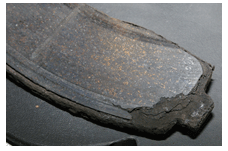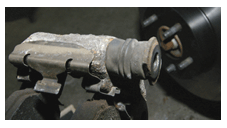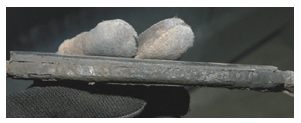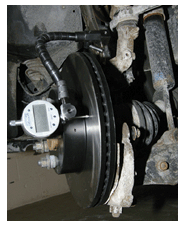The Ford Explorer is one of the most common vehicles on our roads. The system is a product of what Ford learned in the late 1990s about brake systems and what it means to customer satisfaction. It is a relatively robust and trouble-free system. But, it does not mean something cannot go wrong.
The Explorer’s brake system has large enough rotors and pad surface to safely bring the vehicle to a stop and the rotors can last at least the first two brake jobs depending on the driver. The calipers can last more than 100,000 miles before they might require replacement.
 Inspection
Inspection
When you take the vehicle for the initial test drive, look at how the customer uses the vehicle. Look at the tow hitch to see if the customer uses their Explorer for towing. On the test drive, listen for any driveline noises. Many older Explorers are known for having problems with the differential, shafts and axles. The most common symptom is a binding or chattering front differential while the vehicle is turning or braking.
When inspecting the vehicle on a lift, take a close look at the upper control arm bushings. Many customers will associate the rattle and clunking worn bushings can make when the brakes are applied as a brake problem. Verify the symptom with the service writer or customer.
 While performing a moderate stop, observe if there is any ABS activation. This could be a sign of erratic or weak wheel speed sensor signals. It might be a good idea to check it with a scan tool.
While performing a moderate stop, observe if there is any ABS activation. This could be a sign of erratic or weak wheel speed sensor signals. It might be a good idea to check it with a scan tool.
Look at the brake pads for any sign of abuse. Look for signs of rust jacking between the backing plate and friction material. This causes the edge lift and material separation. The customer may also notice noise and vibration.
Make sure to measure the thickness of the pads. The minimum thickness is 3mm, this is a lot of material to the naked eye. Ford specifies that the pads can not vary in thickness from inner-to-outer pad by more than 2mm. Also, Ford specifies that there can only be 3mm of tapered wear.
 If the vehicle has too much thickness variation or tapered wear, it is a sign that there could be problems with the brake hardware or the caliper pistons. Our Explorer Sport Trac had tapered wear on the outer brake pad because the rubber bellows that cover the lower anchor pin were unseated and had seized.
If the vehicle has too much thickness variation or tapered wear, it is a sign that there could be problems with the brake hardware or the caliper pistons. Our Explorer Sport Trac had tapered wear on the outer brake pad because the rubber bellows that cover the lower anchor pin were unseated and had seized.
Explorers have dual-piston floating calipers with phenolic pistons. Inspect the boots for any damage or cracks. When pushing the pistons back in, it is advisable to use a tool that will push the pistons back with equal force. Damage can result to the pistons and seals if the proper tool is not used. There are a number of tools on the market that can help you be more productive.
Technicians are often confused by Ford’s rotor specs. In the past, Ford printed or stamped the minimum and “discard” thickness of the rotors. Now they call it “thickness to machine.” Confused? The minimum thickness is the thickness that the rotors should not drop below before or after machining the rotor. The discard or “thickness to machine” specification is a number (usually 0.7-.9mm added to the minimum thickness) that should be used to determine if a rotor can be machined.
 The rotors should have no more the 0.001” of runout and 0.0004” of thickness variation.
The rotors should have no more the 0.001” of runout and 0.0004” of thickness variation.
While the rotor is off, measure the runout in the wheel bearing hub unit’s flange. The hub unit is one of the first items to fail on the vehicle. In most cases, the first signs of a failure will be an open, erratic or weak wheel speed sensor trouble code.
Brake Rotors Specs
- Front brake rotor minimum thickness: 24.5mm (0.9646")
- Rear brake rotor minimum thickness: 11.0mm (0.4331")
- Front minimum thickness to machine (Discard): 25.1mm (0.98")
- Rear minimum thickness to machine (Discard): 11.6mm (.45")
Repair Procedure
When selecting new friction material for the Explorer, keep in mind the original pads were ceramic. The brake system is set up for this type of material and how the pads and rotor generate and absorb heat. Going with an overly aggressive semi-metallic pad can create problems with brake fluid temperatures. If you receive a remanufactured caliper with steel pistons, send it back. You could be creating more problems then you are solving.
If you are using an on-the-car brake lathe, make sure the ignition is off. Failing to do so can cause the ABS light to come on.
For the caliper anchor pins, use a silicone-based brake grease. Make sure it is compatible with all rubber compounds including nitrile, Teflon, nylon and other synthetic rubbers. For the shims, abutment clips and slides, use a synthetic-based boundary-type lubricants that have a high solids content and typically contain a variety of friction-reducing ingredients, such as molybdenum disulfide (moly or MOS2) and graphite.
Ford recommends applying a thin coat of anti-seize lubricant to the hub flange only. Do not allow the lubricant to make contact with the wheel studs, brake pads or brake disc. Apply a thin coat of anti-seize lubricant to the wheel hub flange.
Torque Specs:
- Bleeder Screws: 16 ft/lbs
- Front/Rear Hose Banjo/Flow Bolt: 26ft/lbs
- Hard Brake Lines Fittings: 13 ft/lbs
- Front Caliper Bolt: 24 ft/lbs
- Rear Caliper Bolt: 24 ft/lbs
- Front Caliper Bracket Anchor Bolts: 100 ft/lbs
- Lug Nuts: 100ft/lbs.
Emergency Brake Adjustments
- Remove the rear rotor.
- Inspect the parking/emergency brake mechanism. Lubricate the parking brake shoes at the point where they contact the brake disc shield using silicone grease.
- Use a brake adjusting gauge/calipers to measure the inside diameter of the drum position of the rear brake disc. Adjust the parking brake shoe clearance of 107 mm (0.142 inch) less than the inside diameter of the drum portion of the rear brake disc.
- Make sure that the parking brake shoes are correctly centered and measure across the center point.
- Rotate the parking brake shoe adjuster wheel to achieve the correct parking brake shoe-to-brake disc.
Bleeding
Ford says that manual bleeding is possible after caliper replacement. But, if you are going to bleed the entire system start at the right rear and move the left rear, finish with the left front. If a ABS hydraulic component is replaced, it will require a scan tool with bi-directional control to get all the air out.













